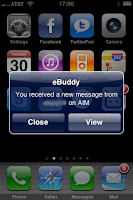As I promised earlier, I'm posting the first IM app that uses push. eBuddy isn't unlike most other apps that allow you to use your favorite IM services, except that you'll stay logged in for half an hour and receive push messages when you get a new message.
Setting up the program was much like similar apps. Create an app-specific account, and add your IM accounts. Aside from the five shown to the right, you can also use ICQ. One of the handy features of this app is the "Sign in to all accounts" button. Caveat emptor; you get your choice of two statuses with this app: Online and Offline. There's no away. On the other hand, if you're using this app because it supports push (and allows you to get messages in real-time), do you need or want to go away?
The buddies tab combines contacts from all accounts in one simple list. You can tap the arrow next to a contact to get more info and options about that contact. Tap on a contact to start a chat with him or her.
The chats themselves deviate from the app's uncluttered interface. It's relatively cluttered, giving (sometimes unnecessary) info at the cost of not displaying many chat messages. With the keyboard up, I typically can see two messages at once. With the keyboard down, you get most of the screen to review past messages. One of the nice features of the chat window I've not seen in similar apps is typing notification. A bit of text appears when your contact is typing. All in all, it works quite well enough for constant use.
When you close the app (or your phone locks), your accounts can stay logged in up to half an hour, contingent on activating this in the options. You can see in the picture what happens when a message arrives. eBuddy tells you who sent the message, and using what service. Like when text messages arrive, you get the choice to ignore it or to deal with it. Messages will accumulate until you open the app. Beware, though, once you close the app messages disappear; there's no logging.
All in all, this is a good solid app, especially for a first release. I'd like to see push work for more than half an hour after logout, but that's a minor thing, for me anyways. One thumb up for concept and one thump up for execution.
Edit: I forgot the best part. It's completely free. No ads, not crippleware, not a lite version.
This Sounds Like It's From The Onion...
-
...but it's not. From a story on the actual, verified navy.mil webpage:
NORFOLK (NNS) -- In order to generate innovative ideas on how to best
maintain the...
12 years ago

















